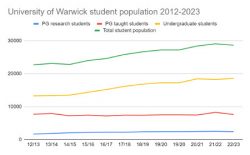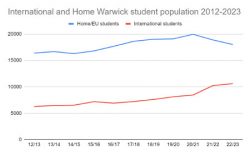Proportion of international students at Warwick rises by 9% in last decade
Analysis conducted by The Boar of Warwick’s student population figures has shown the proportion of international students has risen by close to 10% since 2012.
In the 2012/13 academic year, international students – those not from the UK or EU – made up 28% of students. This year international students have made up 37% of Warwick’s population.
This rise is more pronounced this year especially because in the last two years, home and EU students have fallen in absolute terms. The highest ever total of home or EU students at Warwick came in 2020/21 with 19,939 students. That number has now fallen this year to 18,015.
The number of international students has risen in absolute terms every single year since 2016/17.
10 years ago, there were 6,276 international students studying at Warwick. Now in 2022/23, the total is 10,607.
In the same period, Warwick’s overall student population has risen 26%. Back in 2012/13, the total population stood at 22,667.
The overall Warwick student population for 2022/23 is 28,621.
Within the student population rise, the number of postgraduate taught students only rose by 7% in the last 10 years while postgraduate research students increased by 42% and undergraduate students by 40%.
Warwick essentially divides itself academically into three different categories: Social Sciences, Science and Medicine, and the Arts. The University publishes data on population figures in each of these sectors yearly.
Historically, both Social Sciences and Science and Medicine have been home to far more students than the Arts. In 2022/23, there are 12,834 Social Sciences students, 12,422 from Science and Medicine and only 3,366 from the Arts.
Despite being the largest part of the Warwick community today, Social Sciences has grown the least in the last 10 years with a 22% increase in students. The Arts has grown by 24% and Science and Medicine has risen by 33%.
This investigation and data finding was conducted through a freedom of information request to the University of Warwick and by analysing Warwick’s own publicly available population data.



Comments